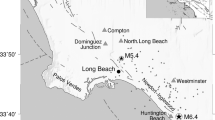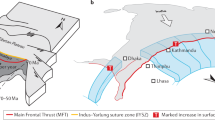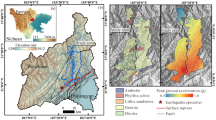Abstract
Local geological conditions, including both near-surface sedimentary layers1,2,3,4 and topographic features5,6,7,8,9, are known to significantly influence ground motions caused by earthquakes. Microzonation maps use local geological conditions to characterize seismic hazard, but commonly incorporate the effect of only sedimentary layers10,11,12. Microzonation does not take into account local topography, because significant topographic amplification is assumed to be rare. Here we show that, although the extent of structural damage in the 2010 Haiti earthquake was primarily due to poor construction, topographic amplification contributed significantly to damage in the district of Petionville, south of central Port-au-Prince. A large number of substantial, relatively well-built structures situated along a foothill ridge in this district sustained serious damage or collapse. Using recordings of aftershocks, we calculate the ground motion response at two seismic stations along the topographic ridge and at two stations in the adjacent valley. Ground motions on the ridge are amplified relative to both sites in the valley and a hard-rock reference site, and thus cannot be explained by sediment-induced amplification. Instead, the amplitude and predominant frequencies of ground motion indicate the amplification of seismic waves by a narrow, steep ridge. We suggest that microzonation maps can potentially be significantly improved by incorporation of topographic effects.
This is a preview of subscription content, access via your institution
Access options
Subscribe to this journal
Receive 12 print issues and online access
$259.00 per year
only $21.58 per issue
Buy this article
- Purchase on Springer Link
- Instant access to full article PDF
Prices may be subject to local taxes which are calculated during checkout




Similar content being viewed by others
References
Singh, S. K. et al. Some aspects of source characteristics of the 19 September 1985 Michoacan earthquake and ground motion amplification in and near Mexico City from strong motion data. Bull. Seismol. Soc. Am. 78, 451–477 (1988).
Hough, S. E. et al. Sediment-induced amplification and the collapse of the Nimitz freeway. Nature 344, 853–855 (1990).
Su, F. et al. The relation between site amplification factor and surficial geology in central California. Bull. Seismol. Soc. Am. 82, 580–602 (1992).
Joyner, W. B. Strong motion from surface waves in deep sedimentary basins. Bull. Seismol. Soc. Am. 90, S95–S112 (2000).
Hartzell, S. H., Carver, D. L. & King, K. W. Initial investigation of site and topographic effects at Robinwood Ridge, California. Bull. Seismol. Soc. Am. 84, 1336–1349 (1994).
Spudich, P., Hellweg, M. & Lee, W. H. K. Directional topographic site response at Tarzana observed in aftershocks of the 1994 Northridge, California earthquake: Implications for mainshock motions. Bull. Seismol. Soc. Am. 86, S193–S208 (1996).
Bouchon, M., Schultz, C. A. & Toksoz, M. N. Effect of three-dimensional topography on seismic motion. J. Geophys. Res. 101, 5835–5846 (1996).
Assimaki, D., Gazetas, G. & Kausel, E. Effects of local soil conditions and topographic aggravation of seismic motion: Parametric investigation and recorded field evidence from the 1999 Athens earthquake. Bull. Seismol. Soc. Am. 95, 1059–1089 (2005).
Lee, S. J., Chan, Y. C., Komatitsch, D., Huang, B. S. & Tromp, J. Effects of realistic surface topography on seismic ground motion in the Yangminshan region of Taiwan based on the spectral-element method and LiDAR DTM. Bull. Seismol. Soc. Am. 99, 681–693 (2009).
Allen, T. I. & Wald, D. J. On the use of high-resolution topographic data as a proxy for seismic site conditions (Vs30). Bull. Seismol. Soc. Am. 99, 935–943 (2009).
Yong, A., Hough, S. E., Abrams, M. J. & Wills, C. J. Preliminary results for a semi-automated quantification of site effects using geomorphometry and ASTER satellite data for Mozambique, Pakistan, and Turkey. J. Earth Syst. Sci. 117, 797–808 (2009).
Wills, C. J. et al. A site-conditions map for California based on geology and shear-wave velocity. Bull. Seismol. Soc. Am. 90, S187–S208 (2000).
http://earthquake.usgs.gov/earthquakes/eqinthenews/2010/us2010rja6/ (last accessed 10 May 2010).
Lambert, M. L, Gaudin, J. & Cohen, R. Carte Geologique D’Haiti, Feuille Sud-Est: Port-au-Prince, 1 :250,000, IMAGEO-CNRS (1987).
http://www.dlr.de/en/desktopdefault.aspx/tabid-6213/10205_read-22076/ (last accessed 31 August 2010).
Sanchez-Sesma, F. J. Diffraction of elastic SH waves by wedges. Bull. Seismol. Soc. Am. 75, 1435–1446 (1985).
Aki, K. Local site effects on weak and strong ground motion. Tectonophysics 218, 93–111 (1993).
Iwahashi, J. & Pike, R. J. Automated classification of topography from DEMS by an unsupervised nested-means algorithm and a three-part geometric signature. Geomorphology 86, 409–440 (2007).
Acknowledgements
We thank A. Frankel and D. Assimaki for their constructive reviews of the manuscript. We also thank the US Agency for International Development-Office of Foreign Disaster Assistance for their support of the field deployment. We further acknowledge the individuals without whose support the deployment would not have been possible: G. Domond and G. Laborde from Voila Corporation; J-H. and C. Ceant; the owners of the Hotel Montana; the US Army Corps of Engineers; the staff of the Plaza Hotel; and G. Groth, D. Lindwall and other personnel at the US Embassy in Port-au-Prince.
Author information
Authors and Affiliations
Contributions
S.E.H., J.R.A., D.A., D.G., M.G.J., J.Z.M., M.M., B.S-L.M. and C.P. contributed to the planning and execution of the field deployment; S.E.H., J.R.A., D.G. and A.Y. contributed to data processing and analysis.
Corresponding author
Ethics declarations
Competing interests
The authors declare no competing financial interests.
Rights and permissions
About this article
Cite this article
Hough, S., Altidor, J., Anglade, D. et al. Localized damage caused by topographic amplification during the 2010 M 7.0 Haiti earthquake. Nature Geosci 3, 778–782 (2010). https://doi.org/10.1038/ngeo988
Received:
Accepted:
Published:
Issue Date:
DOI: https://doi.org/10.1038/ngeo988
This article is cited by
-
Analysis of local site effects on seismic ground response under Boumerdes earthquake scenario: case study of Zeralda site of Algeria
Innovative Infrastructure Solutions (2024)
-
Surface topography and site stratigraphy effects on the characteristic parameters of design response spectra
Bulletin of Earthquake Engineering (2024)
-
Amplification of Ground Vibration on a Rocky Hill and Its Environs Under Cylindrical SH Waves
Rock Mechanics and Rock Engineering (2024)
-
Investigation of topographic amplification on ground motions considering spatial variability of soil properties
Stochastic Environmental Research and Risk Assessment (2024)
-
Scattering of plane SH waves by a concentric semi-cylindrical discontinuity and canyon
Journal of Engineering Mathematics (2024)



